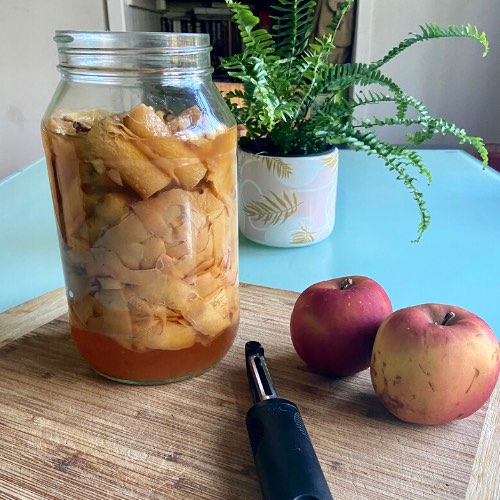
Scrap Apple Cider Vinegar

I am always on the look out for ways to get the most out of my food scraps. Our farmers work very hard to produce bountiful crops of delicious fruit and veg and it seems such a waste to toss any of it out.
Scrap apple cider vinegar uses apple peel and cores and with a little bit of water and sugar you can quickly turn these often discarded food scraps into vinegar suitable for cooking and cleaning.
After some experimenting in our kitchen here is our recipe for scrap apple cider vinegar.
Scrap Apple Cider Vinegar
- 6 Apple peels and cores ((you can always use more)[timer minutes=0][/timer])
- 2 tbsp Your choice of sugar – I use coconut palm sugar
- 500 ml Boiling water
Boil some filtered water in the kettle
Combine 500ml of boiled water with 2 tablespoons of sugar and set aside to cool.
Combine apple scraps and cooled sugar water in a wide-mouth glass jar and stir ensuring the apple peel and cores are completed covered by water (you may not need all the sugar water you made). Cover with a muslin cloth.
- Each day stir your ferment with a clean sterile spoon several times a day and after a few days (depending on the weather) your blend should start to bubble and begin to smell slightly alcoholic.
- Once it starts bubbling you only need to stir it once a day.
Ferments are individual and the time it takes to become vinegar will vary. You’ll find the warmer the weather the faster you will make vinegar. After about a week your vinegar will start to taste sour and once it stops bubbling and its ready to strain. At this point you can strain the fruit out through a fine muslin cloth. Don’t forget to compost the fruit scraps.
Add the liquid into a new glass bottle, cover it with the muslin or loosely put the lid on, now you are ready for the second stage ferment. Leave the bottle on the bench for 6 weeks and then pop it the fridge to finish the second ferment. Th second ferment can take up to 6 months. Taste it as you go along and when you like the flavour it has developed it's ready to use.
Store it in the fridge or in a cool dark spot. You now have your very own scrap apple cider vinegar to use for cooking and cleaning.
